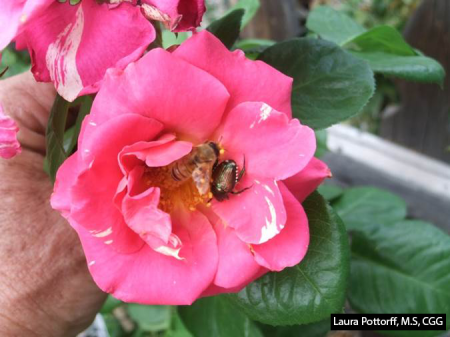Management Strategies for Private Property Owners
Integrated Pest Management (IPM)
Use of a variety of integrated pest management (IPM)/Plant Health Care (PHC) approaches, which combine multiple management tools, is highly encouraged.
Management of Japanese beetle is complicated because adults and grubs (larvae) are very different from one another and cause injury to a variety of hosts. Control of just one life stage will not necessarily guarantee control of the other.
Successful management strategies for this invasive pest are most effective when more than one of the following techniques are utilized:
1.Utilize plants that are not susceptible to Japanese beetle whenever possible. This can mean many things to many people; while one might not want to plant roses, grapes or otherhighlyattractive plants in their landscape,another might choose to eliminate turfgrass or other attractive plants.
2. Reduce irrigation to turfgrass areas. Japanese beetle adult females seek out well irrigated Kentucky bluegrass or other turfgrasses in which to lay their eggs. Try to make this area as unattractive to the pest as possible.
3. Hand pick or physically remove adults. Research suggests that this is actually a very effective management strategy as it reduces feeding-induced plant volatiles. It’s the plant volatiles emitted when a beetle feeds that attracts more and more. So by picking the beetles off and dropping them into a bucket of soapy water each evening, there are fewer beetles which leads to less feeding and less volatiles released to attract more beetles. Japanese beetles drop readily when disturbed to they can easily be collected by holding a jar or container beneath filled with soapy water.
4. Use of biological controls.Many biological controls for Japanese beetle have been researched.
- Currently, the use of entomopathogenic nematodes (microscopic rounds worms that only parasitize insects) has been shown to be effective for controlling grubs. Cost of implementation is high and results are inconsistent when compared to conventional controls. Available in many garden centers or by mail order,Steinernema glaseriandHeterorohabiditis bacteriophoramay be effective controls if attention to pre and post irrigation is noted.
- An additional biological control called Milky Spore, a bacterial disease of grubs, can also be purchased for Japanese beetle control, however, research has not shown this product to be very effective.
- Alternative controls such as products containing azadiractin a derivative from neem seeds are also labeled for control of Japanese beetle. Look for trade names such as Bioneem, Aazatin or Azasol. While these products may provide a short, but effective impact on adults they must be reapplied frequently.
- Animals such as chickens feed on Japanese beetles.
5. Use of labeled pesticide controls. Insecticide treatment of turf to control larvae (grubs) has been the most common and largely the most effective management strategy employed against Japanese beetle. The timing of insecticide applications is critical. Use insecticides for grub control in early summer, for control of adults, apply when feeding and damage are observed. Always read and follow pesticide label directions. Many of the insecticides that control Japanese beetle are also highly toxic to bees and other pollinators. Pesticide labels will contain information describing how to use the product while protecting pollinators. It is essential and the law that all applicators of pesticides follow the pesticide label. Avoid application of pesticides to all blooming plants when pollinators are active in the area.
- Labeled Pesticides for management of Japanese Beetle
-
Common Name Life Stage Chemical Class Pollinator Safety Issues? Acephate Adults Organophosphate Highly toxic to bees Bifenthrin Adults Pyrethroid Highly toxic to bees Cyfluthrin Adults Pyrethroid Highly toxic to bees Deltamethrin Adults Pyrethroid Highly toxic to bees Permethrin Grubs, Adults Pyrethroid Highly toxic to bees Carbaryl Grubs, Adults Carbamate Highly toxic to bees Chlorantraniliprole Grubs Anthranilic diamide No bee toxicity statement Imidacloprid Grubs, Adults Chloronicotinyl These products are very toxic to bees, do not apply while bees are visiting the area.
Clothianidin Grubs, Adults Thianicotinyl These products are very toxic to bees, do not apply while bees are visiting the area. Acetamiprid Adults Chloronicotinyl These products are very toxic to bees, do not apply while bees are visiting the area. Dinotefuran Adults Chloronicotinyl These products are very toxic to bees, do not apply while bees are visiting the area.
